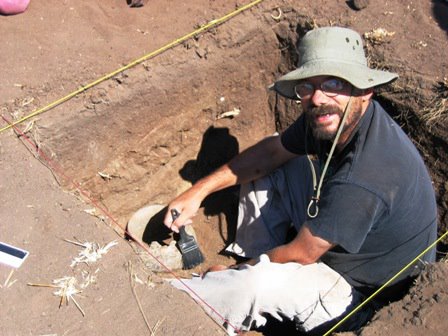 I'm back from a great week up at the Eagle Lake Field Station teaching the Osteoarchaeology Course with my colleagues from CSU Chico and the University of Utah. Check out the view from the conference room above (and no, that's not what happens to students who fail the exam! - not my photo, either - it's courtesy of a CSU grad student who will remain nameless until she prefers fame and fortune by appearing on Northstate Science...yeah, right...).
I'm back from a great week up at the Eagle Lake Field Station teaching the Osteoarchaeology Course with my colleagues from CSU Chico and the University of Utah. Check out the view from the conference room above (and no, that's not what happens to students who fail the exam! - not my photo, either - it's courtesy of a CSU grad student who will remain nameless until she prefers fame and fortune by appearing on Northstate Science...yeah, right...).Long week, but always well worth the time and energy. The class was fantastic as usual; lectures on skeletal anatomy and natural history of the major classes of vertebrates followed by lots of time in the lab identifying bone elements; we ended with lectures on the application of zooarchaeological data to problems in California archaeology, reconstruction of Holocene environments and historical ecology. We also provided special discussions on specialized techniques using bones and teeth: dental increment analysis, isotope analysis and ancient DNA.
 Of course, we didn't just spend all our time in the lab and conference rooms. We took our usual trip to the "Bat Cave" where we sat beneath a cave ceiling covered with hundreds of western pipistrelles (Pipistrellus hesperus), North America's smallest bat. Although the bats are entering and leaving the cave by the hundreds (using the same small entrance we humans go through...thank natural selection for echolocation!) the hardest part is getting in the cave without using lights as we want to disturb the bats as little as possible. Once inside and some subdued lights come on, the ceiling is literally moving with the small bats. Fortunately all the bat guano is in the center of the cave floor, although the bats occasionally urinate on those below (nothing personal, I'm sure...). My 14 year old daughter joins me on these adventures and the Bat Cave is one of her favorite activities.
Of course, we didn't just spend all our time in the lab and conference rooms. We took our usual trip to the "Bat Cave" where we sat beneath a cave ceiling covered with hundreds of western pipistrelles (Pipistrellus hesperus), North America's smallest bat. Although the bats are entering and leaving the cave by the hundreds (using the same small entrance we humans go through...thank natural selection for echolocation!) the hardest part is getting in the cave without using lights as we want to disturb the bats as little as possible. Once inside and some subdued lights come on, the ceiling is literally moving with the small bats. Fortunately all the bat guano is in the center of the cave floor, although the bats occasionally urinate on those below (nothing personal, I'm sure...). My 14 year old daughter joins me on these adventures and the Bat Cave is one of her favorite activities.And no trip to the field station could be complete without a night drive or two. These events are somewhat difficult to describe. Their purpose is scientific, but through the years they have also attained an air of cultural tradition about them as well. Imagine 5-10 biologists and zooarchaeologists in the back of truck driving slowly through sagebrush and forest with spotlights and nets, searching for small (and not so small) fauna to capture. Creatures wandering across our path suddenly find themselves blinded by lights and surrounded by a bunch of excitedly chattering bipedal monkeys (ok, apes...but if you saw us you'd understand why "monkeys" is a better term) who discuss the anatomy, adaptations and sexual proclivities of animals before releasing them unharmed. Before releasing, however, those who wish to shower themselves with good fortune in their pursuit of science may "kiss the paunch" of the captured animal. As far as we know, "paunch kissing" is a phenomena found only among those who frequent the CSU Biological Field Station...
(Here, yours truly has just finished planting one on the paunch of a large bull frog while my daughter (herself a veteran "paunch kisser"), looks on...I wonder: if PZ ever caught a squid...).
 Night drives make for long periods with no sleep (our drive this week went until 2:00 am), but one must still be up by 4:30 am to take advantage of the best opportunities to fish for the famed Eagle Lake trout (Onchorynchus mykiss). Unfortunately, June is not the best time for trout fishing here and all of us walked away empty handed. We did, however, enjoy a wonderful morning on the lake, filled with ducks, grebes, pelicans, ospreys and eagles.
Night drives make for long periods with no sleep (our drive this week went until 2:00 am), but one must still be up by 4:30 am to take advantage of the best opportunities to fish for the famed Eagle Lake trout (Onchorynchus mykiss). Unfortunately, June is not the best time for trout fishing here and all of us walked away empty handed. We did, however, enjoy a wonderful morning on the lake, filled with ducks, grebes, pelicans, ospreys and eagles.In a couple of weeks we take my daughter's Girl Scout troop up to the field station for a more scientific version of Camporee, where we can expose them to the sights and sounds of the natural history of the Eagle Lake basin. Anyone for the Bat Cave?




No comments:
Post a Comment